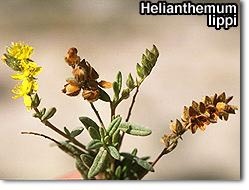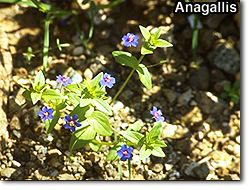 Tidal creeks cut into the coastline from Sharjah northwards. Mangroves are abundant, but low, and the landspits in between the creeks are covered with the same grasses and halophytes, that occur all along the coast. But these areas are also the last places where an abundance of the edible mushroom faqah still occurs. These fungi live in symbiosis with the small woody perennial shrub Helianthemum lippii . The extremely wet spring of 1995-1996 brought out the mushrooms in great multitudes - and local people in droves to collect them! Nearer to Ras al-Khaimah high sand-dunes with impressive ghaf (Prosopis cinerea ) forests come close to the coast. In the springtime these dunes are covered with the lovely ephemerals, Eremobium aegyptiacum , Silene villosa , Senecio glaucus , Malva parviflora and several Launaea species. A narrow gravel plain leads north of Ras al-Khaimah to the point where the high Musandam mountains descend straight into the sea. Tidal creeks cut into the coastline from Sharjah northwards. Mangroves are abundant, but low, and the landspits in between the creeks are covered with the same grasses and halophytes, that occur all along the coast. But these areas are also the last places where an abundance of the edible mushroom faqah still occurs. These fungi live in symbiosis with the small woody perennial shrub Helianthemum lippii . The extremely wet spring of 1995-1996 brought out the mushrooms in great multitudes - and local people in droves to collect them! Nearer to Ras al-Khaimah high sand-dunes with impressive ghaf (Prosopis cinerea ) forests come close to the coast. In the springtime these dunes are covered with the lovely ephemerals, Eremobium aegyptiacum , Silene villosa , Senecio glaucus , Malva parviflora and several Launaea species. A narrow gravel plain leads north of Ras al-Khaimah to the point where the high Musandam mountains descend straight into the sea.
The plains around Ras al-Khaimah are among the most fertile of the country and plantations prosper. Abandoned fields in the springtime have a special fascination for plant lovers. There are all the common favourites like Anagallis arvensis , Aerva javanica , Astragalus species , Lotus halophilus , Monsonia nivea and the bindweed Convolvulus arvensis . Aloe vera is an introduced species that has established itself as a 'feral' plant.
 Towards the mountains the gravel plains are thick with stands of Prosopis juliflora , the indestructible mesquite, probably imported into the country in times long gone by. Starting from these plains, another four-hour drive leads through boulder-strewn Wadi Bih to a high pass, where some of the original montane flora can be found in those places where fences protect it against the voracious appetite of goats and donkeys. Dark purple Ixiolirion tataricum lilies, and bright blue irises vie for attention with the showy pink Gladiolus italicus and the strange Muscaris longipes. Smaller weeds, more commonly found in European meadows, also occur, including Vicia sativa , Galium setaceum , and strong-smelling herbs like Salvia aegyptiaca . Under overhanging large boulders tiny plants like the yellow Vicoa pentanema and the starry Spergula fallax stand side by side with the small white daisies of Anthemis odontostephana and the yellow globes of Matricaria aurea. The most conspicuous plants of these high plains are the thorny Astragalus spinosus bushes, the arabian almond Amygdalus arabicus and the graceful pink-flowering Moringa peregrina trees. A hairpin track with magnificent views zig-zags down into the steep-sided canyon of Wadi Khabb Shamsi, one of the sites of the strange Periploca aphylla , and leads into the Dibba gravel plains, where Acacia tortilis trees spread their flat-topped umbrellas. I have noticed a sort of symbiosis between this Acacia and Lycium shawii, the desert thorn. The latter, wherever it grows by itself, is often cropped into stunted shapes by domestic animals, and the only specimens that manage to thrive are those that grow between the protecting branches of the Acacia . The Acacia itself often shows a double umbrella: most of the tree, which is browsed by camels remains low and shrublike, but in the middle, where camels cannot reach, some branches have managed to grow out and reach their proper height to form the second umbrella. Towards the mountains the gravel plains are thick with stands of Prosopis juliflora , the indestructible mesquite, probably imported into the country in times long gone by. Starting from these plains, another four-hour drive leads through boulder-strewn Wadi Bih to a high pass, where some of the original montane flora can be found in those places where fences protect it against the voracious appetite of goats and donkeys. Dark purple Ixiolirion tataricum lilies, and bright blue irises vie for attention with the showy pink Gladiolus italicus and the strange Muscaris longipes. Smaller weeds, more commonly found in European meadows, also occur, including Vicia sativa , Galium setaceum , and strong-smelling herbs like Salvia aegyptiaca . Under overhanging large boulders tiny plants like the yellow Vicoa pentanema and the starry Spergula fallax stand side by side with the small white daisies of Anthemis odontostephana and the yellow globes of Matricaria aurea. The most conspicuous plants of these high plains are the thorny Astragalus spinosus bushes, the arabian almond Amygdalus arabicus and the graceful pink-flowering Moringa peregrina trees. A hairpin track with magnificent views zig-zags down into the steep-sided canyon of Wadi Khabb Shamsi, one of the sites of the strange Periploca aphylla , and leads into the Dibba gravel plains, where Acacia tortilis trees spread their flat-topped umbrellas. I have noticed a sort of symbiosis between this Acacia and Lycium shawii, the desert thorn. The latter, wherever it grows by itself, is often cropped into stunted shapes by domestic animals, and the only specimens that manage to thrive are those that grow between the protecting branches of the Acacia . The Acacia itself often shows a double umbrella: most of the tree, which is browsed by camels remains low and shrublike, but in the middle, where camels cannot reach, some branches have managed to grow out and reach their proper height to form the second umbrella.
|

